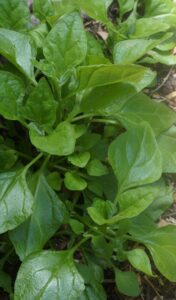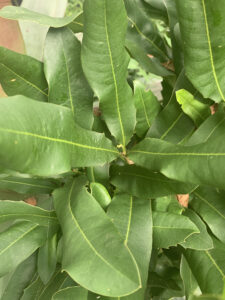
Australian plant foods – edible and eatable?
By Clive Larkman
Bush Tucker, Aussie Edibles, Native Food, are just some of the group names given to Australian native food plants over the past few decades. Like other major climatic regions, we have a mass of edible plant genera, some as leafy greens, some as fresh fruit, some as tubers and rhizomes, and some as herbs and spices. Unlike most other regions, we have not undertaken any extensive or targeted breeding. Plants like sweetcorn and apples have been studied and bred for centuries whereas plants like anigozanthos and syzygium have had some targeted breeding for their garden appeal, but minimal, if any, for their flavour or nutritional properties.
Indigenous Australians have used the Australian plant palette for thousands of years. Due to their more nomadic communities, they were more concerned with selection than breeding. Targeted plant breeding requires a farming lifestyle and an understanding of sexual propagation, to generate better cultivars, and a proficiency in asexual propagation, to achieve true societal benefit from the breeding. I suspect that due to their comprehensive understanding and connection with the land, they had their preferred plants and plant stands. When in a new area, they were able to quickly find what they needed.
In the same way as the plants of South America quickly moved around the world once the sailors started coming through, Australian plants started to appear in many countries. Indeed, one of our classic native trees, the River Red Gum has the Latin name Eucalyptus camaldulensis which acknowledges the tiny Italian town where the plant was first ‘named’. The seed had moved through Italy before the botanists had even described the plant. The plants of South America spread around the world due to their value as food plants, whereas Australian plants were taken abroad due to their beauty and unique growing conditions.

Australia was settled by Europeans who brought with them their desire for their ‘home’ foods. Although Australia is a hot, dry continent, most European plants will grow and perform well here, so the early Europeans were quick to establish large farms of ‘their’ native foods. They only needed a source of water and our ample sun to give good, high-yielding crops. The farmers brought generations of breeding and farming practices with them which enabled them to quickly establish good supplies of European food types. The drier climate and distance from the monocultures of Europe meant the plants were far less susceptible to the pests and diseases that were a major issue in their countries of origin. This all meant a rapid growth in the farming of European crops.
The other push away from developing an Australian food industry, was the success early settlers had with sheep and cattle to supply the European countries with wool and leather. Broad acre cropping also grew quickly, so most of the money and research was focused on these crops. The next major food influence was the large Asian community that came to work in the mines, goldfields and cane farms. They wanted their home foods which required learning to grow those crops rather than learning to cook with Australian plants. Then, post World War 2, we had the massive resettlement of European migrants which again put pressure on learning to grow other foods rather than cook with Australian plants.
There is one native plant that has worldwide sales. The Macadamia tree is from a small genus of four species, M. integrifolia, M. jansenii, M. ternifolia and M. tetraphylla. Three of these form the worldwide Macadamia industry. The plant is native to north-eastern NSW and south-eastern Queensland where it has been a stable part of the subtropical forest for over 60million years. It has been commercially grown in Australia and Hawaii since the mid-1880s. It has one of the hardest nuts and needs serious processing equipment to form an industry. Like most commercial plants, it was the development of asexual propagation that enabled the plantations to grow and the nut to spread around the world.

(Image: John Fitzsimmons)
Like so many Australian developments, we had to wait for another country to build the industry before we saw its potential. Now, although we are a massive producer of the nuts, the biggest producers are in South Africa and Hawaii. The beauty of macadamia is that it is so well adapted to the environment of the NSW/Queensland border region, does minimal damage to the environment and is a truly sustainable food crop.
Over the last forty or so years, the public interest in Australian bush foods has waned like any other fashion. There have been a range of factors that have stopped the plants from becoming a key part of the Australian food scene, either as a commercial crop or home-grown plant. The two main barriers for native plants are lack of breeding and difficulty in growing. The first means many of the pants are edible but not really eatable. We all hear about the use of Prostanthera rotundifolia as a native mint, however it has vaguely mint or rosemary flavoured foliage that adds some interesting notes to slow baked meat, but doesn’t stimulate the taste buds and leave the mouth hungering for more. Muntries (Kunzea pomifera) has had some popular periods and some targeted breeding but not enough to get it onto the supermarket shelves. There are many other plants that are making their appearance in commercial food products as background flavours. The Strawberry Gum (Eucalyptus olida) is used in the form of powdered foliage or essential oil as a flavouring in confectionary. The demand is large but the capacity for supply is restricted due to low seed yields and low seed viability. There are many other plants that are being used for jams and sauces which I will look at next month. I feel that this time the wave of interest in native food plants washes through the community, there will be more plants that become part of the Australian (and maybe the world) food palette.
